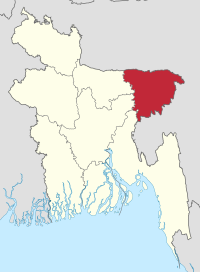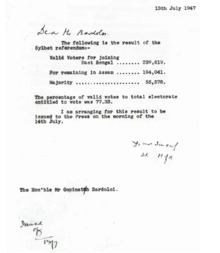| ||||
| Should Sylhet join the province of East Bengal in Pakistan? | ||||
| Outcome | Karimganj subdivision remains in the India, the rest of Sylhet District joins the Pakistan. | |||
|---|---|---|---|---|
 Map of Sylhet District showing subdivisions and majority voting. Green represents area in favor of joining East Bengal (Pakistan) and Orange represents area in favor of remaining part of Assam and joining India. Map of Sylhet District showing subdivisions and majority voting. Green represents area in favor of joining East Bengal (Pakistan) and Orange represents area in favor of remaining part of Assam and joining India. | ||||
The 1947 Sylhet referendum was held in Sylhet District of the Assam Province of British India to decide whether the district would remain in undivided Assam and therefore within the post-independence Dominion of India, or leave Assam for East Bengal and consequently join the newly created Dominion of Pakistan. The referendum's turnout was in favour of joining the Pakistani union; however, the district's Karimganj subdivision remained within the Indian state of Assam.
History
Prior to the British arrival in the region in late eighteenth century, the Sylhet Sarkar was a part of the Bengal Subah of the Mughal Empire. Initially, the Company Raj incorporated Sylhet into its Bengal Presidency; however, 109 years later on 16 February 1874, Sylhet was made a part of the non-regulation Chief Commissioner's Province of Assam (North-East Frontier) in order to facilitate Assam's commercial development. This transfer was implemented despite a memorandum of protests being submitted to the Viceroy, Lord Northbrook, on 10 August from the district's Sylheti-majority population which consisted of both Hindus and Muslims. These protests subsided when Northbrook visited Sylhet to reassure the people that education and justice would be administered from the city of Calcutta in Bengal, as well as when the Hindu zamindars of Sylhet realized the opportunity of employment in Assam's tea estates and a market for their produce.
After the first partition of Bengal in 1905, Sylhet was briefly reincorporated with Eastern Bengal and Assam, as a part of the new province's Surma Valley and Hill Districts division. However, this reorganization was short-lived as Sylhet once again became separated from Bengal in 1912, when Assam Province was reconstituted into a Chief Commissioner's Province. By the 1920s, organisations such as the Sylhet Peoples' Association and Sylhet–Bengal Reunion League mobilized public opinion, demanding Sylhet's reincorporation into Bengal. However, the leaders of the Reunion League, including Muhammad Bakht Mauzumdar and Syed Abdul Majid, who were also involved in Assam's tea trade, later opposed the transfer of Sylhet and Cachar to Bengal in September 1928 during the Surma Valley Muslim Conference; supported by Abdul Majid's Anjuman-e-Islamia and Muslim Students Association.
Background

The partition of India was to happen along religious lines in August 1947. Muslim-majority areas would be combined to form the new Pakistan while non-Muslim and Hindu-majority areas would remain in India. Sylhet was a Muslim-majority Sylheti-speaking district in Assam, which was a Hindu-majority Assamese-speaking province. The Government of Assam believed that removing Sylhet would make the state more homogeneous and strongly unified as a result. Assam's Chief Minister, Gopinath Bordoloi, stated in 1946 that his wish was to "hand over Sylhet to East Bengal". The British Raj declared on 3 July 1947 that a referendum would be held on 6 July 1947 to decide the future of Sylhet. H. C. Stock was appointed as the commissioner of the referendum. Brigadier Mohinder Singh Chopra was in command of the "SYL Force" (Sylhet Force) made to keep the referendum peaceful, which is why there were no cases of riot or murder during the time.
Result
The majority of the population voted in favour of joining Pakistan. This was implemented via Article 3 of the Indian Independence Act of 18 July 1947. The Radcliffe Line published on 17 August 1947 gave some areas of Sylhet – mainly Karimganj – to India, while the rest of Sylhet joined East Bengal, even though Karimganj had a Muslim-majority population which had opted for Pakistan, unlike some other areas in Sylhet like Moulvibazar. The putative cause of this was the plea of a group led by Abdul Matlib Mazumdar.

India received three and a half thanas of Sylhet. Along with Karimganj, Zakiganj was also to be a part of independent India, but this was prevented by a delegation led by Sheikh Mujibur Rahman. Thus, most of the Sylhet District joined East Pakistan, which later emerged as the new country of Bangladesh in 1971 following the Bangladesh War of Independence.

The result of the referendum was largely welcomed by the local Assamese population.
| Subdivision | Total Voters | Electorate | Voter Turnout | Votes | |||
|---|---|---|---|---|---|---|---|
| Assam
(India) |
% | East Bengal (Pakistan) | % | ||||
| Sylhet North | 1,41,131 | 1,07,252 | 76.00 | 38,871 | 36.24 | 68,381 | 63.76 |
| Sylhet South (Maulvi Bazar) | 79,024 | 65,189 | 82.49 | 33,471 | 51.34 | 31,718 | 48.66 |
| Habiganj | 1,35,526 | 91,495 | 67.51 | 36,952 | 40.39 | 54,543 | 59.61 |
| Sunamganj | 90,891 | 77,926 | 85.74 | 34,211 | 43.90 | 43,715 | 56.10 |
| Karimganj | 1,00,243 | 81,798 | 81.60 | 40,536 | 49.56 | 41,262 | 50.44 |
| Total | 5,46,815 | 423,660 | 77.48 | 1,84,041 | 43.44 | 2,39,619 | 56.56 |
See also
- 1947 North-West Frontier Province referendum, a similar referendum held in present-day Khyber Pakhtunkhwa, Pakistan
References
- ^ Chowdhury, Dewan Nurul Anwar Husain (2012). "Sylhet Referendum, 1947". In Sirajul Islam; Miah, Sajahan; Khanam, Mahfuza; Ahmed, Sabbir (eds.). Banglapedia: the National Encyclopedia of Bangladesh (Online ed.). Dhaka, Bangladesh: Banglapedia Trust, Asiatic Society of Bangladesh. ISBN 984-32-0576-6. OCLC 52727562. OL 30677644M. Retrieved 7 January 2025.
- Fazal, Tanweer (2013). Minority Nationalisms in South Asia. Routledge. pp. 53–54. ISBN 978-1-317-96647-0.
- Hossain, Ashfaque (2013). "The Making and Unmaking of Assam-Bengal Borders and the Sylhet Referendum". Modern Asian Studies. 47 (1): 262. doi:10.1017/S0026749X1200056X. JSTOR 23359785. S2CID 145546471.
It was also decided that education and justice would be administered from Calcutta University and the Calcutta High Court respectively.
- Hossain, Ashfaque (2013). "The Making and Unmaking of Assam-Bengal Borders and the Sylhet Referendum". Modern Asian Studies. 47 (1): 262. doi:10.1017/S0026749X1200056X. JSTOR 23359785. S2CID 145546471.
They could also see that the benefits conferred by the tea industry on the province would also prove profitable for them. For example, those who were literate were able to obtain numerous clerical and medical appointments in tea estates, and the demand for rice to feed the tea labourers noticeably augmented its price in Sylhet and Assam enabling the Zaminders (mostly Hindu) to dispose of their produce at a better price than would have been possible had they been obliged to export it to Bengal.
- Fazal, Tanweer (2013). Minority Nationalisms in South Asia. Routledge. pp. 54–55. ISBN 978-1-317-96647-0.
- Bhuyan, Arun Chandra (2000). Nationalist Upsurge in Assam. Government of Assam. OCLC 47256838.
- "History - British History in depth: The Hidden Story of Partition and its Legacies". BBC. Retrieved 20 November 2016.
- Daniyal, Shoaib. "With Brexit a reality, a look back at six Indian referendums (and one that never happened)". Scroll.in. Retrieved 20 November 2016.
- "Independence Day: The man who set up the joint check post at Attari-Wagah border in 1947". The Indian Express. 13 August 2023. Retrieved 5 May 2024.
- Qureshi, Murad (14 August 2017). "Sylhet's own Brexit – Partition referendum of 1947". Murad Qureshi. Retrieved 1 June 2021.
- "Recovering Sylhet". Himal Southasian. 22 November 2012. Retrieved 20 November 2016.
- "Assam Election Results – What does it mean for Bangladesh?". The Daily Star. 21 May 2016. Retrieved 20 November 2016.
- Ali, AMM Shawkat (15 August 2004). "Bangabandhu's death anniversary special: As I look back". The Daily Star. Archived from the original on 26 May 2021. Retrieved 26 May 2021.
- LaPorte, R (1972). "Pakistan in 1971: The Disintegration of a Nation". Asian Survey. 12 (2): 97–108. doi:10.2307/2643071. JSTOR 2643071.
- Fazal, Tanweer (2013). Minority Nationalisms in South Asia. Routledge. p. 56. ISBN 978-1-317-96647-0.
